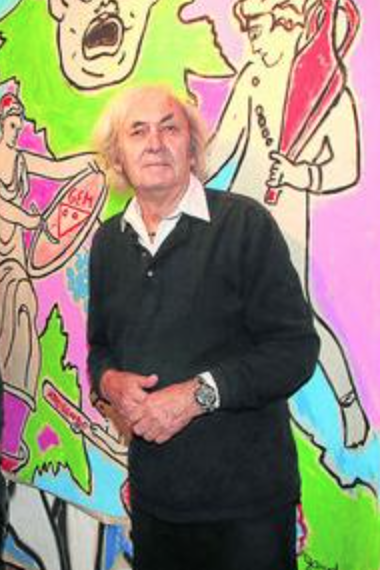You have /5 articles left.
Sign up for a free account or log in.

Walter Gaudnek
MySpace
The visual arts involve sometimes-painful critiques of student work. But the University of Central Florida has warned a well-known professor that he crossed the line into harassment with some salty comments allegedly directed at a female student in an advanced painting class.
“You should just paint a vagina on it, it would be much better,” Walter Gaudnek, the professor, is accused of telling an undergraduate last semester. “You can’t paint the Virgin Mary like this, she would be fucking pissed,” he added, according to a letter of instruction placed in his personnel file and provided to Inside Higher Ed via an open-records request. News of the letter was originally reported by The Orlando Sentinel.
The unnamed student in question filed a complaint against Gaudnek with the university’s IntegrityLine reporting service in October, saying that the professor had been unprofessional and offensive. Public documents provide little additional context, such as what, exactly, the student was painting. Gaudnek, 85, is a pop artist who often deals with religious imagery.
The student also reported that Gaudnek was a “horrible teacher who yells at his student’s [sic] and discourages everyone from making the work they want to make. I’ve been [at the university] for almost two years and I’ve never had a teacher curse directly at me.”
The report triggered an investigation into Gaudnek’s teaching, which included interviews with students. According to the letter of reprimand, their reviews were mixed, with some reporting similar experiences and one report of “veiled retaliation or threat.” A review of Gaudnek’s annual evaluations suggests his classroom demeanor “could use improvement,” it adds.
On the flip side, student witnesses praised Gaudnek’s teaching methods and course content. The letter ultimately reminds Gaudnek that he must interact with students without belittling them and without directing profanities or other aggressive language at them.
To be “absolutely clear,” the letter says, “academic freedom does not involve using offensive language to evaluate or critique students’ work. … It is imperative that profanity used by you for the purposes of instruction be contained" only to relevant topics -- in this case, certain kinds of pop art.
Gaudnek, who did not respond to a request for comment, argued to administrators that he uses profanity to discuss pop art, according to the letter. He did not admit to disparaging the student as she alleged, but said repeatedly that academic freedom afforded him the right to say what he wanted in class. He reportedly agreed to put a disclaimer on his syllabi saying some classes would involve strong language out of necessity.
No further action is planned against Gaudnek, who has been teaching at Central Florida since 1970. The Czech-born professor has had a long career as both an artist and teacher, and has his own museum in Europe. According to his faculty bio, he “bases his teaching philosophy with accent on the individual.”
It’s My Class, and I’ll Say What I Want To
Some professors will agree that they may say what they wish in class. But the American Association of University Professors, which promotes academic freedom, says otherwise.
“We don’t hold the position that academic freedom provides for unlimited rights to say whatever one wants in class,” said Hans-Joerg Tiede, associate secretary of academic freedom, tenure and governance at AAUP. The association's Statement on Professional Ethics, for example, says professors should not harass their students.
AAUP also maintains that inquiries into an instructor’s professionalism -- such as whether one’s speech constitutes harassment -- should be led by faculty peers. But it considers a letter of reprimand to be a minor sanction, which may be imposed without a prior hearing before faculty peers -- so long as the professor can appeal it.
Tiede said Gaudnek’s case in some ways recalled that of Teresa Buchanan at Louisiana State University, Baton Rouge, who was dismissed -- despite having tenure -- for repeatedly using the word “fuck” in her classes. In that case, due to the severe sanction imposed, AAUP wrote to LSU that it had distanced itself “from the mainstream of our secular research universities by dismissing a professor for misconduct simply for having used language that is not only run-of-the-mill these days for much of the academic community but is also protected conduct under principles of academic freedom.”
Buchanan taught education, which arguably heightens her responsibility to model appropriate classroom behavior. Does art, to which emotion and individualism are central, differ? Tiede again pointed to the need for peer review.
As for AAUP, he said, “We would certainly not subscribe to the [administration’s statement] that faculty members may not use 'offensive language' to evaluate a student's work. We do subscribe to the position that a faculty member may not harass a student when evaluating their work, or anywhere else, for that matter.”
Morgan T. Paine, associate professor of art at Florida Gulf Coast University and a member of the College Art Association’s Education Committee, said art tends to defy strict professional guidelines; association standards for the bachelor’s degree in studio art say that assessment is “inherent” to the discipline, but otherwise defer to institutional policies and curricula. Similarly, Paine said that any artist who is part of an academic community -- namely Gaudnek -- is “able to pursue and profess his sense of truth within the context” of his discipline and institution.
Paine’s own experience is that art is “a low-coherency field in which experts routinely disagree about even foundational principles,” he said, and in which judgments of individual faculty members “vary widely, and pedagogical tactics are almost always situational.”
As for critique, he said, a subset of art professors believe a session “in which no one cries is a failure,” and “that personal, wrenching, disorienting criticism is a legitimate way to engage a student’s core beliefs and accelerate the change process that is central to any educational experience.” On the other hand, he added, “not all art faculty think that personality destruction, and the belittling of student’s core values -- even when they are apparently without merit in the faculty’s view -- is educationally constructive.”
Of Gaudnek in particular, Paine said that if “using crude language does not disqualify you from being president, then it likely ought not to be an impediment for being empowered to conduct a critique for upper-level university painting students. His word choices would not be my first choice of language when critiquing student work, but it is language that reflects a specific, albeit harsh, point of view, within the context of a particular situation.”
For Mark Van Proyen, an art critic and associate professor of painting at San Francisco Art Institute, it all comes down to context — largely absent from the public record of Gaudnek’s case — since “one person’s loquacity could be another person's hate speech.”
“If the language was pointed at work that the student had presented in fulfillment of some assignment, it should be protected by the code of academic freedom,” he said in an email, “but if the colorful language was a disparagement of the student, another standard comes into play.”
Van Proyen said one red line would be language that violated Title IX of the Education Amendments of 1972, which prohibit gender-based discrimination in education. Falling short of that standard, though, he continued, “it seems that the right of a professor to indulge in colorful speech should go in greater authority” than the “needs of oversensitive students [who] want to wax censorious over points of propriety that do not belong in an environment where honest inquiry is to be prized.”
Clara Lieu, a visual artist and adjunct professor at the Rhode Island School of Design who blogs about art school, said that even after teaching studio art for over a decade, “I still find art critiques to be endlessly challenging for both teachers and students. There are infinite directions an art critique can potentially take, and the public format of a group art critique creates pressure that can be inherently nerve-racking for many students. The tone and direction of an art critique can vary tremendously depending on the specific teacher, the group of students and the artwork being discussed.”
Lieu said she’s had group critiques at RISD “that played out like a Victorian drama, critiques where students burst into tears, and others where the entire class was laughing so hard our stomachs hurt,” for example.
Regardless of the topic at hand, though, “it's critical that mutual respect between everyone in the discussion is always maintained. I do believe that it is possible to give a tough critique on a student's artwork, but also to be respectful toward the student in terms of how that critique is delivered,” she said. That doesn't mean suppressing one's professional opinions to "coddle" students, or otherwise sacrificing one's academic freedom, but rather investing effort "toward fostering an appropriate, respectful atmosphere in a group critique.”





